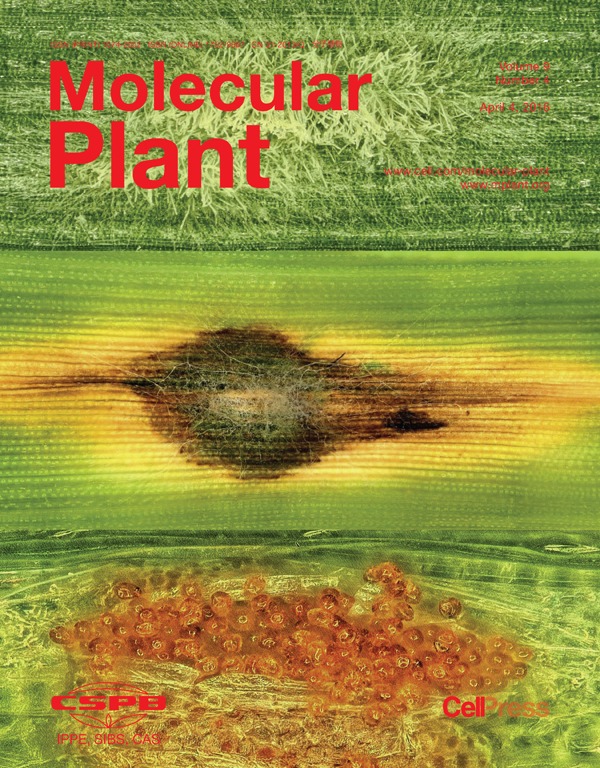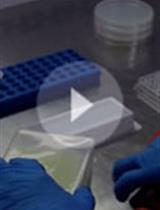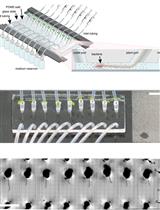- EN - English
- CN - 中文
Inoculation of Rice with Different Pathogens: Sheath Blight (Rhizoctonia solani), Damping off Disease (Pythium graminicola) and Barley Powdery Mildew (Blumeria graminis f. sp. hordei)
用不同病原体接种水稻:纹枯病(立枯丝核菌)、猝倒病(禾生腐霉菌)和大麦白粉病(大麦白粉病菌)
发布: 2016年12月20日第6卷第24期 DOI: 10.21769/BioProtoc.2070 浏览次数: 13859
评审: Marisa RosaAnonymous reviewer(s)
Abstract
To prevent yield losses in plant cultivation due to plant pathogens, it is an important task to find new disease resistance mechanisms. Recently, Weidenbach et al. (2016) reported about the capacity of the rice gene OsJAC1 to enhance resistance in rice and barley against a broad spectrum of different pathogens. Here, we describe the respective protocols used by Weidenbach and colleagues for inoculation of rice with the basidiomycete Rhizoctonia solani, the oomycete Pythium graminicola and the ascomycete Blumeria graminis f. sp. hordei (Bgh).
Keywords: Rice (水稻)Background
Following the observation that transcripts of the rice gene OsJAC1 accumulated after pathogen attack or treatment with chemical resistance inducers, transgenic rice plants with constitutive expression or knockout of this gene were investigated in response to inoculation with fungal pathogens. To cover a broad pathogen spectrum, economically important representatives of ascomycete fungi (Magnaporthe oryzae, Blumeria graminis f. sp. hordei), basidiomycete fungi (Rhizoctonia solani) and oomycetes (Pythium graminicola) were chosen. Using protocols for standardized and even inoculation, an enhanced disease resistance phenotype was established for the transgenic plants constitutively expressing OsJAC1 while the respective knockout plants showed enhanced susceptibility (Weidenbach et al., 2016). A detailed bio-protocol for M. oryzae inoculation on rice is already available (Akagi et al., 2015), therefore we focus here on the inoculation protocols for R. solani, P. graminicola and Bgh.
As causal agent of rice sheath blight R. solani is one of the two most important rice diseases (Lee and Rush, 1983). The fungus overwinters as sclerotia or mycelium in the soil and infects rice sheaths by cuticular penetration or through stomata resulting in lesions, necrosis and leaf death (Ou, 1985). Of different methods available for R. solani inoculation, in the present study a time- and space-saving detached leaf assay is described, that was slightly modified from a protocol provided by Monika Höfte (Ghent University, personal communication).
P. graminicola is a causal agent of seedling damping-off and root rot resulting in stunting and yield loss (Hendrix and Campbell, 1973). In this study P. graminicola was inoculated on rice roots growing on agar plates using a protocol adapted from Van Buyten and Höfte (2013).
Fungi of the B. graminis species invade epidermal cells of their host plants with specialized feeding structures called haustoria. All other parts of the fungal mycelium are developed on the leaf surface thereby causing typical powdery mildew disease symptoms. The disease is of permanent importance in cereal agriculture (Dean et al., 2012). Rice plants do not have any powdery mildew pathogens. However, rice can be inoculated with Bgh which allows the investigation of nonhost resistance mechanisms (e.g., Abbruscato et al., 2012; Weidenbach et al., 2016). For an evenly distributed inoculation density, rice leaves have to be fixed and inoculated in a settling tower, as described for barley (Weidenbach et al., 2014).
Materials and Reagents
- Square Petri dishes, (120 x 120) x 17 with vents (Greiner Bio One, catalog number: 688102 )
- Round Petri dishes, 94 x 16 with vents (Greiner Bio One, catalog number: 633180 )
- Filter paper, e.g., Rotilabo-round filters, type 113A, 125 mm (Carl Roth, Germany)
- 50 ml tubes (Cellstar tubes) (Greiner Bio One, Germany)
- Surgical 3M Micropore tape (3M Deutschland, Germany)
- Aluminum foil
- Cover glass
- Removable adhesive labels, e.g., multipurpose labels (Avery Zweckform, Germany)
- Rice (Oryza sativa L. japonica), transgenic plants and respective wild type
Note: Cultivar Nipponbare used in this study was kindly provided by the Center de cooperation internationale en recherche agronomique pour le developpement (CIRAD, Montpellier, France). - Barley (Hordeum vulgare) susceptible to Bgh.
Note: Cultivar Ingrid used in this study was kindly provided by Paul Schulze Lefert (Max-Planck Institute for Plant Breeding Research, Cologne, Germany). - Rhizoctonia solani.
Note: The isolate NL84 used in this study was kindly provided by Monica Höfte (Ghent University, Gent, Belgium). - Pythium graminicola.
Note: The isolate 132 used in this study was kindly provided by Monica Höfte (Ghent University, Gent, Belgium). - Blumeria graminis f. sp. hordei.
Note: In this study race K1 (Hinze et al., 1991) was used, which was kindly provided by Paul Schulze-Lefert (Max Planck Institute for Plant Breeding Research, Cologne, Germany). - Potato extract glucose agar (PDA) (Carl Roth, Germany)
- Distilled water
- Gamborg B5 medium including vitamins (Duchefa Biochemie, catalog number: G0210.0025 )
- Agar-Agar, Kobe I (Carl Roth, Germany)
- Sodium hypochlorite (or commercially available bleach water, ‘Eau de Javel’)
Equipment
- Scissor, scalpel
- Plant growth chamber for rice cultivation (settings: 15 h light/9 h dark period, 24 °C, 75-80% humidity)
- Plant growth cabinet for constant Bgh propagation on barley (settings:16 h light/8 h dark period, 18 °C, 65% humidity)
- Incubator for maintenance of fungal cultures (22 °C, constant darkness)
- Horizontal shaker
- Thoma cell counting chamber (Marienfeld, Germany)
- Light microscope (ca. 150x magnification)
- Trays for Bgh inoculation (min. 30 x 15 cm2)
Note: Area should at least correspond to the magnitude of two-week old rice plants. - Spore settling tower (e.g., a plastic tent of ca. 1 m height with an inoculation opening at the top, see example in Figure 3C)
Procedure
文章信息
版权信息
© 2016 The Authors; exclusive licensee Bio-protocol LLC.
如何引用
Delventhal, R., Loehrer, M., Weidenbach, D. and Schaffrath, U. (2016). Inoculation of Rice with Different Pathogens: Sheath Blight (Rhizoctonia solani), Damping off Disease (Pythium graminicola) and Barley Powdery Mildew (Blumeria graminis f. sp. hordei). Bio-protocol 6(24): e2070. DOI: 10.21769/BioProtoc.2070.
分类
植物科学 > 植物免疫 > 病害生物测定
微生物学 > 微生物-宿主相互作用 > 体内实验模型 > 植物
您对这篇实验方法有问题吗?
在此处发布您的问题,我们将邀请本文作者来回答。同时,我们会将您的问题发布到Bio-protocol Exchange,以便寻求社区成员的帮助。
提问指南
+ 问题描述
写下详细的问题描述,包括所有有助于他人回答您问题的信息(例如实验过程、条件和相关图像等)。
Share
Bluesky
X
Copy link












